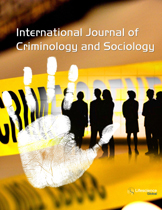ijcs
Abstract : Territorial – Means a Spatial, or a New Approach to the Old Criminological Problem Solving
|
|
Abstract: The article presents a new approach to the possibilities of using the method of analysis of patterns of territorial differences formation in crime rates in regions of the same country in order to expand the understanding of crime causative complex as a whole. The author proves that the effectiveness of territorial approach to crime causes understanding will reach its greatest extent when it is a criminological analysis of territorial-spacial systems functioning, a revelation of their destabilizing factors, sources of disorganization and social tension. But this requires a preliminary solution to the problem of identifying the patterns of territorial socio-economic systems functioning, that the author proposes to do on the basis of the "New Economic Geography" modern achievements. For such an approach, the name "spatial analysis of causative crime complex" is claimed. This analysis, carried with reference to some regions of Central Federal District of Russia, demonstrated the received results importance for a better mechanism of theoretical understanding of crime existence in society. In particular, the conclusion was made that the main reason of crime rates increasing within the territorial socio-economic system (specifically, the Russian Federation region) is the imbalance between theoretically estimated potential of socio-economic development of a definite region at a certain stage of society development and actual vector and dynamics of such development in reality. Keywords: Causes of crime, territorial differences in crime rates, spatial analysis. |
Abstract : Preventing Human Trafficking in Global and Vietnamese Context
|
|
Abstract: Crime prevention is an outreach measure to stop crime before it can occur. Prevention measures vary in different countries. In Vietnam, human trafficking prevention includes a range of strategies that are implemented by law enforcement agencies, other government agencies, social organisations, the media, community level organisations and individuals.In this paper, the author intends to exam the human trafficking situation and crime prevention in the world and Vietnam. Keywords: Human trafficking, prevent, global, Vietnam. |
Abstract : Cyberbullying among Emerging Adults: Exploring Prevalence, Impact, and Coping Methods
|
|
Abstract: Cyberbullying has been a concern among adolescents, parents and educators for years for its seemingly boundless reach and potential harm it can cause. Aggressors are often masked with anonymity and targeted individuals may feel powerless over what others do online. While such issues and concerns are prevalent among adolescent ages, college students are not invulnerable from parallel experiences. In the US, Macdonald and Roberts-Pittman (2010) found less than ten percent of college students were cyberbullies but over one-fifth reported as cybervictims. This study explored prevalence of cyber victimization and perpetration as well as evidence of damaging effects and impact. Among the college student sample of 1,921, participants were 18-25 years (mean age 20.1), just over half Caucasian (55.5%) and female (67.9%). Results indicated victimization most often occurred through phones (19.9%) and social networks (20.4%). For perpetration, prevalence was low across all platforms, however phone use was the preferred means of attacking others (6.5%). Low self-esteem was a significant predictor for victimization and perpetration. For males only, social capital was a significant predictor of victimization. Future directions and recommendations for follow-up studies are discussed as well as the importance of this study in relation to college student activities and behaviors. Keywords: Cyberbullying, Perpetration, Emerging Adults, Self-Esteem. |
Abstract : What is Religious Misconduct: A Typological Analysis of the Crimes Motivated by Polytheistic Religion, Using the Chinese Folk Religion as an Example
|
|
Abstract: In terms of political function, religion is usually defined by criminologists/sociologists as an institution of social control. While religion can assist state managers to maintain the status quo and to safeguard social order, religion, under certain circumstances, can become an antisocial force as well. In this paper, the criminogenic side of religions will be examined. By using the Chinese folk religion as an example, this paper will demonstrate that polytheistic religions can become unstable social organizations. Four topics will be addressed in this paper. First, the research paradigms that can help crime researchers examine the subject of religious misconduct will be summarized. Then the features shared by polytheistic religions will be proposed. The third part will look at the primary traits of Chinese folk religion. Finally, by using the Chinese folk religion as an instance, the diverse contexts under which polytheistic religions can breed deviant/criminal behaviors will be analyzed. Keywords: Crime of trust, Crime of obedience, Karma, Rebirth, Sex Crime. |






















